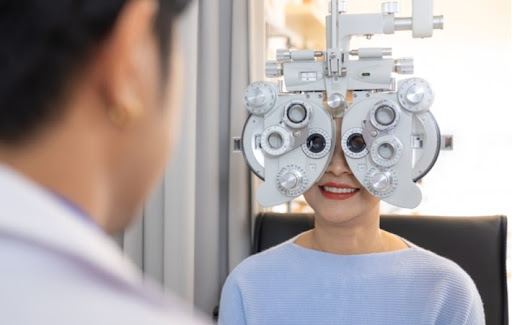Explaining Astigmatism
You’ve probably heard the term astigmatism or know someone with this common vision problem, but you may not know the details of this condition or how it’s diagnosed.
Astigmatism can result from an irregularly shaped cornea, or the lens inside the eye having a misshaped curve. These conditions change the way light reaches your retina, the light-sensitive surface located at the back of your eye.
People with astigmatism often experience blurry or distorted vision. Vision problems can increase or decrease due to changes in the curvature of the lens inside your eye.
Optometrists cannot prevent astigmatism because it is an abnormality of the eye, but various treatments are available to help patients achieve clear vision.
There are 2 types of astigmatism:
- Corneal astigmatism: This condition occurs when the cornea is irregularly curved.
- Lenticular astigmatism: This condition occurs when the lens is irregularly curved.
What Causes Astigmatism?
Experts cannot agree on why cornea and lens shapes vary from person to person, but studies indicate that this condition could be genetic. Astigmatism can present itself at birth, develop later in life, or occur due to an eye injury.
Nearsightedness (myopia) and farsightedness (hyperopia) often go hand-in-hand with astigmatism. These conditions are referred to as refractive errors because they affect how the eye bends light.
You are at a higher risk of developing astigmatism if you:
- Have a family history of astigmatism.
- Have a family history of eye diseases, like keratoconus.
- Have scarring on your cornea.
- Have corneal thinning.
- Have pronounced nearsightedness (myopia).
- Have pronounced farsightedness (hyperopia).
- Have had eye procedures in the past, like cataract surgery.
Symptoms of Astigmatism
Some patients have this condition, but don’t experience any symptoms. Each person is different, and symptoms can vary in severity.
People with astigmatism may experience the following symptoms:
- Blurry vision at any distance
- Distorted vision at any distance
- Issues with seeing at night
- Eye discomfort
- Eyestrain
- Squinting
- Irritated eyes
- Frequent headaches
It’s important to note that even with these symptoms, you may not have astigmatism. Always speak to your optometrist for a diagnosis and options for treatment.

Diagnosing Astigmatism
Great news! Your optometrist can diagnose astigmatism at your routine comprehensive eye exam. There are several tests and devices available to help your doctor achieve precise results:
Visual Acuity Assessment
Your optometrist will ask you to read a series of letters on a distance chart to assess your clarity of vision at certain distances.
Refraction Test
In a refraction test, the doctor places various lenses in front of your eye, and uses light to measure how it bends through your cornea. Following this, a phoropter may be used to evaluate the focusing power of your eyes, helping the optometrist find a lens that allows the clearest possible vision.
Keratometry
Keratometry helps your optometrist evaluate the curvature of your cornea. This test is conducted by focusing a circle of light on your eyes’ curve and measuring the reflection.
Corneal Topography
Corneal topography is becoming a more popular method of diagnosing astigmatism. This computer-assisted diagnostic tool creates a contoured map of the cornea and provides your optometrist with the precise details of its shape.
Treatments for Astigmatism
Not every patient with astigmatism experiences vision problems, but treatments are available if your eyesight is affected.
Corrective Eyeglasses & Contact Lenses
Your optometrist can correct vision problems associated with astigmatism by providing eyeglasses and contact lenses with a special cylindrical lens. This lens helps compensate by giving additional power to a specific area in the visual field.
Many patients are interested in frame-less vision correction, and initially, optometrists could use only rigid contact lenses to help with astigmatism. However, there are now soft lenses available called toric contact lenses.
Everyone’s eyesight is different, and we recommend contacting our experts at The Eye Care Team to discuss the best lens options for your vision.
Orthokeratology (Ortho-K)
Ortho-K lenses are generally worn overnight. These lenses are designed to mold the cornea into an ideal shape. This corneal reshaping helps light focus correctly on the retina, providing clear vision during the day without the use of contact lenses or glasses.
The visual corrections from these lenses are only temporary, but patients can maintain clear vision with regular use.
Surgery
For patients with more severe cases of astigmatism, your optometrist may recommend procedures like LASIK or PRK.
Laser-assisted in situ keratomileusis (LASIK) is a popular surgery for refractive errors, where an ophthalmologist reshapes corneal tissue using a pre-programmed laser to the desired prescription.
Photorefractive keratectomy (PRK) is another type of laser eye surgery. The main difference between PRK and LASIK is how your doctor gains access to the corneal tissue.
Life With Astigmatism
You’ve received your diagnosis from the optometrist, so now what?
Astigmatism is a common vision problem, and studies have shown that approximately 1 in 3 Americans have this condition. Everyone’s eyesight is unique, and some patients will experience more pronounced symptoms; others will not notice a change at all.
The most vital step is to select a treatment that works best for your vision and your lifestyle.
If you have questions about astigmatism or would like to book a comprehensive eye exam, contact one of our friendly experts at The Eye Care Team. We can help guide you through your initial diagnosis and help get you on the path to clearer vision.



